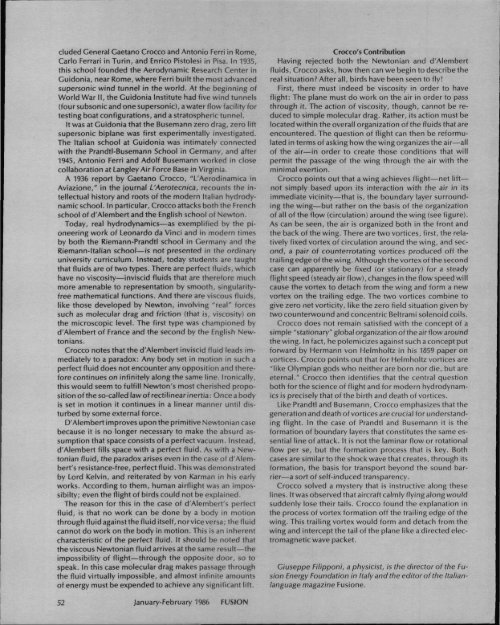And Hypersonic Flight
And Hypersonic Flight
And Hypersonic Flight
Create successful ePaper yourself
Turn your PDF publications into a flip-book with our unique Google optimized e-Paper software.
eluded General Gaetano Crocco and Antonio Ferri in Rome,Carlo Ferrari in Turin, and Enrico Pistolesi in Pisa. In 1935,this school founded the Aerodynamic Research Center inGuidonia, near Rome, where Ferri built the most advancedsupersonic wind tunnel in the world. At the beginning ofWorld War II, the Guidonia Institute had five wind tunnels(four subsonic and one supersonic), a water flow facility fortesting boat configurations, and a stratospheric tunnel.It was at Guidonia that the Busemann zero drag, zero liftsupersonic biplane was first experimentally investigated.The Italian school at Guidonia was intimately connectedwith the Prandtl-Busemann School in Germany, and after1945, Antonio Ferri and Adolf Busemann worked in closecollaboration at Langley Air Force Base in Virginia.A 1936 report by Gaetano Crocco, "L'Aerodinamica inAviazione," in the journal L'Aerotecnica, recounts the intellectualhistory and roots of the modern Italian hydrodynamicschool. In particular, Crocco attacks both the Frenchschool of d'Alembertand the English school of Newton.Today, real hydrodynamics—as exemplified by the pioneeringwork of Leonardo da Vinci and in modern timesby both the Riemann-Prandtl school in Germany and theRiemann-ltalian school—is not presented in the ordinaryuniversity curriculum. Instead, today students are taughtthat fluids are of two types. There are perfect fluids, whichhave no viscosity—inviscid fluids that are therefore muchmore amenable to representation by smooth, singularityfreemathematical functions. <strong>And</strong> there are viscous fluids,like those developed by Newton, involving "real" forcessuch as molecular drag and friction (that is, viscosity) onthe microscopic level. The first type was championed byd'Alembert of France and the second by the English Newtonians.Crocco notes that the d'Alembert inviscid fluid leads immediatelyto a paradox: Any body set in motion in such aperfect fluid does not encounter any opposition and thereforecontinues on infinitely along the same line. Ironically,this would seem to fulfill Newton's most cherished propositionof the so-called law of rectilinear inertia: Once a bodyis set in motion it continues in a linear manner until disturbedby some external force.D'Alembert improves upon the primitive Newtonian casebecause it is no longer necessary to make the absurd assumptionthat space consists of a perfect vacuum. Instead,d'Alembert fills space with a perfect fluid. As with a Newtonianfluid, the paradox arises even in the case of d'Alembert'sresistance-free, perfect fluid. This was demonstratedby Lord Kelvin, and reiterated by von Karman in his earlyworks. According to them, human airflight was an impossibilty;even the flight of birds could not be explained.The reason for this in the case of d'Alembert's perfectfluid, is that no work can be done by a body in motionthrough fluid against the fluid itself, nor vice versa; the fluidcannot do work on the body in motion. This is an inherentcharacteristic of the perfect fluid. It should be noted thatthe viscous Newtonian fluid arrives at the same result—theimpossibility of flight—through the opposite door, so tospeak. In this case molecular drag makes passage throughthe fluid virtually impossible, and almost infinite amountsof energy must be expended to achieve any significant lift.Crocco's ContributionHaving rejected both the Newtonian and d'Alembertfluids, Crocco asks, how then can we begin to describe thereal situation? After all, birds have been seen to fly!First, there must indeed be viscosity in order to haveflight: The plane must do work on the air in order to passthrough it. The action of viscosity, though, cannot be reducedto simple molecular drag. Rather, its action must belocated within the overall organization of the fluids that areencountered. The question of flight can then be reformulatedin terms of asking how the wing organizes the air—allof the air—in order to create those conditions that willpermit the passage of the wing through the air with theminimal exertion.Crocco points out that a wing achieves flight—net lift—not simply based upon its interaction with the air in itsimmediate vicinity—that is, the boundary layer surroundingthe wing—but rather on the basis of the organizationof all of the flow (circulation) around the wing (see figure).As can be seen, the air is organized both in the front andthe back of the wing. There are two vortices, first, the relativelyfixed vortex of circulation around the wing, and second,a pair of counterrotating vortices produced off thetrailing edge of the wing. Although the vortex of the secondcase can apparently be fixed (or stationary) for a steadyflight speed (steady air flow), changes in the flow speed willcause the vortex to detach from the wing and form a newvortex on the trailing edge. The two vortices combine togive zero net vorticity, like the zero field situation given bytwo counterwound and concentric Beltrami solenoid coils.Crocco does not remain satisfied with the concept of asimple "stationary" global organization of the air flow aroundthe wing. In fact, he polemicizes against such a concept putforward by Hermann von Helmholtz in his 1859 paper onvortices. Crocco points out that for Helmholtz vortices are"like Olympian gods who neither are born nor die, but areeternal." Crocco then identifies that the central questionboth for the science of flight and for modern hydrodynamicsis precisely that of the birth and death of vortices.Like Prandtl and Busemann, Crocco emphasizes that thegeneration and death of vortices are crucial for understandingflight. In the case of Prandtl and Busemann it is theformation of boundary layers that constitutes the same essentialline of attack. It is not the laminar flow or rotationalflow per se, but the formation process that is key. Bothcases are similar to the shock wave that creates, through itsformation, the basis for transport beyond the sound barrier—asort of self-induced transparency.Crocco solved a mystery that is instructive along theselines. It was observed that aircraft calmly flying along wouldsuddenly lose their tails. Crocco found the explanation inthe process of vortex formation off the trailing edge of thewing. This trailing vortex would form and detach from thewing and intercept the tail of the plane like a directed electromagneticwave packet.Giuseppe Filipponi, a physicist, is the director of the FusionEnergy Foundation in Italy and the editor of the Italianlanguagemagazine Fusione.52 January-February 1986 FUSION
















